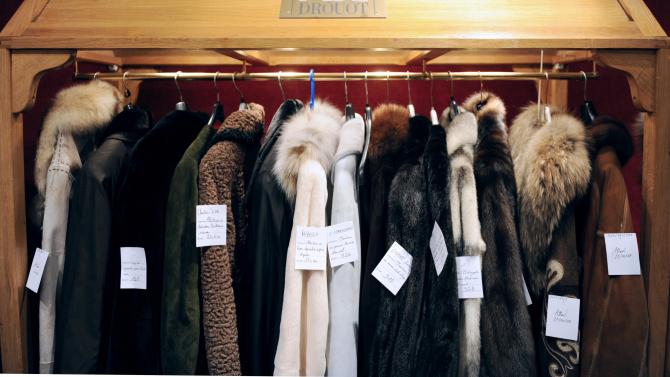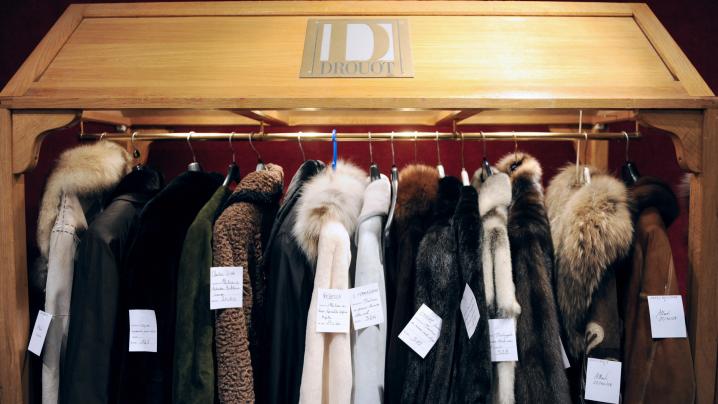[ad_1]

Fancy furs and vintage couture seduce buyers at a Paris auction Oct. 27, 2008.
LIONEL BONAVENTURE/AFP/Getty Images
I wish I could get my mom to stop supporting the fur and diamond trades. She knows the horrors that go into both industries but still refuses to stop buying fur coats and diamond jewelry.
Now, I remember the first time my mom bought a fur coat. I remember how luxurious the coat was and how glamorous my mom looked in it. It even had her name stitched on the inside lining! I could tell by the way my mom carried herself that it was a big deal to have a fur coat. (Full length, at that. Not a jacket.) Every time she wore it out, usually with a fancy dress and high-heeled shoes, I watched her in awe. But then I got old enough to learn where fur coats came from, and I wasn’t so impressed anymore.
I can’t say I’m an animal-rights activist: I eat meat and dairy and wear leather. But I do draw the line at fur. I can’t and won’t ever wear a fur coat. I’ve seen the People for the Ethical Treatment of Animals videos about how animals are often tortured in the name of fashion, and I just can’t unsee what I’ve seen. A few years ago, I talked to my mom about how fur coats are made and how the animals are often tortured in the name of fashion.
Her response: “Right. Now that I can afford a fur coat, we’re not supposed to wear them? Too bad, PETA!”
I have to admit I cracked up laughing at my mom’s response at first because in some ways I understood her point. This is a woman who was raised by a single mom in Newark, N.J. My grandmother didn’t have the money to make sure my mom and her sisters were dressed in the finest gear in high school. And my mom worked her own way through college after she married and began a family. My mom straight up pulled herself through three or four tax brackets by the time she was in her second career as a high school English teacher. She’s careful with her money, invests well and treats herself when she wants to. So I totally see why the things she grew up coveting, like fur coats, are not so easy to give up.
Diamonds are another sore spot for me. I happily accepted the rock my husband put on my finger 10 years ago. But then, as I started doing more research on diamond mines, I could no longer ignore the truth: The majority of diamonds sold in the United States are coming at a great cost to people in places like Sierra Leone. I didn’t return my diamond engagement ring; nor did I stop wearing the diamond wedding band that once belonged to my grandmother. But I don’t buy diamonds or support the diamond trade.
My mom, on the other hand, puts diamonds in the same category as her fur coats: Don’t come for me when it was all good a generation ago.
I desperately want my mom to come over to my side as it pertains to diamonds and fur. I’m not perfect when it comes to activism. But I try to do my part by at least staying educated and doing what I can to effect change in whatever small way I can. I don’t expect my mom to get rid of the furs and diamonds she already owns. But I don’t want her to buy either of them again.
Can we check our parents on the choices they make? If we know better (and try to do better), should we expect the same from our parents? We can’t demand that they change their ways—so how far do we push? My mom had to teach me right from wrong when I was child. As her (now adult) child, can I teach her right from wrong as well?
Many years ago, my sister and I bought our first fur coats after getting raises on our jobs. We were so excited. For our generation, there was something about a fur coat that made a formal outfit more glamorous and caused the envy of women who didn’t have one. Hollywood helped to glamorize furs in movies and through actresses and entertainers who could afford to buy them. The most an average African-American woman could afford to own was maybe a mink stole, which my mom had in the 1950s. And many times, the well-dressed preacher’s wife made her appearance in church decked out in a fur stole draped over her shoulders to the approval and admiration of the congregation.
Of course, it wasn’t common knowledge in the ’40s, ’50s, ’60s and even the ’70s, the way animals were trapped in torturous ways for their pelts that eventually became fur coats. I was so shocked, saddened and surprised about the process of capturing animals—but not enough to stop buying and wearing my furs. I have the right to decide what causes I support and how I choose to support them. I don’t answer to PETA.
As for diamonds, a few years ago I saw the movie Blood Diamond, which shows the abuse and horror that is part of the diamond industry in Sierra Leone. I have to say, what I saw made me sick to my stomach. But I still own diamond rings, bracelets and earrings. And clearly, I’m not the only one who is still supporting the diamond industry. It’s hard to change your visceral feelings about certain things—and luxury items are something I’ve worked hard to be able to buy.
Parents want their children to become educated, caring people and be advocates for change in their communities—and the world. I’m proud that my daughter Aliya is well-read and committed to learning the truth about important issues like the fur and diamond industries. But, ultimately, she’ll have to accept that just as she continues to shop at H&M, knowing that it has an awful history of violating child-labor laws, parents, like all people, are often walking contradictions—sometimes draped in fur and diamonds.
[ad_2]




















